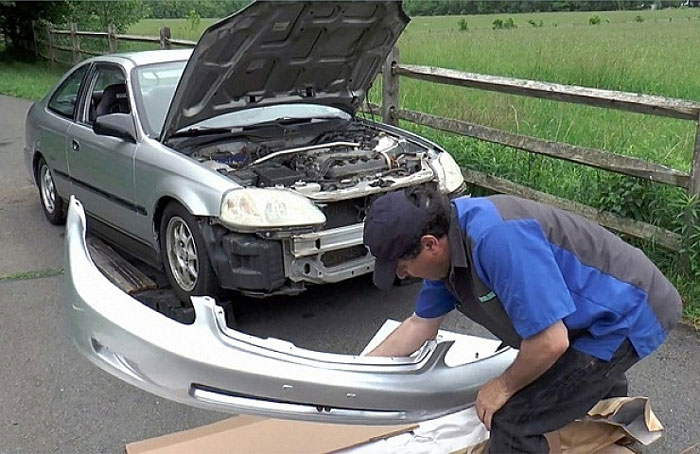Repainting a bumper can be a challenging job, especially when you’re unsure about the costs involved. Whether it’s due to a minor fender bender or just wear and tear, understanding the expenses can help you budget effectively and avoid any surprises. In my experience, the cost to repaint a bumper varies widely based on factors like the extent of damage, type of paint, and labor rates in your area.
From DIY solutions to professional services, each option comes with its own price tag and set of considerations. I’ll break down the typical costs, what influences them, and how you can make the most well-informed choice for your vehicle.
Factors Affecting Bumper Repainting Costs
Understanding the factors influencing bumper repainting costs helps in making an well-informed choice. These factors determine the overall expense and quality of the repaint job.

Type of Bumper Material
Different bumper materials affect repainting costs. Each material requires specific preparation and paint types.
- Plastic: The most common bumper material. Costs less due to simpler preparation and paint adhesion.
- Fiberglass: Prone to cracks. Requires more intensive repair and high-quality paint.
- Carbon Fiber: Premium material. Needs specialized labor and paint. Costs significantly higher.
- Metal: Less common in modern vehicles. Demands rust treatment and durable paint. Higher costs involved.
Extent of Damage
Damage levels on the bumper significantly impact repainting costs. More severe damage involves more labor and materials.
- Minor Scratches: Simple and cost-effective to repair. Often only need touch-up paint.
- Dents: Require more labor to smooth out before painting. Moderate costs apply.
- Cracks: May need filler or patching. Involve higher costs for repair and paint.
- Multiple Damage Areas: Increases labor, time, and materials. Costs rise substantially.
Understanding these factors helps estimate the repainting costs more accurately.
Cost of DIY Bumper Repainting
Repainting a bumper yourself can save money, but it’s vital to know the expenses involved to avoid surprises.
Required Materials and Tools
Materials:
- Automotive Paint: High-quality paint ensures a professional finish. $20-$50 per spray can or quart depending on the brand.
- Primer: Ensures paint adheres well to the bumper. $10-$30.
- Clear Coat: Protects paint and adds shine. $20-$40.
- Sandpaper: Grades from 320 to 2000 grit are needed for different stages. $10-$20 for assorted packs.
- Masking Tape: Protects areas you don’t want to paint. $5-$15.
- Cleaning Solvent: Prepares the bumper by removing contaminants. $10-$20.
Tools:
- Spray Gun: Offers a more even finish compared to spray cans, though spray cans are an affordable alternative. $50-$150 for decent models.
- Sanding Block: Ensures uniform pressure while sanding. $5-$15.
- Dust Mask: Protects you from inhaling particles. $5-$10.
- Microfiber Cloths: For cleaning and drying the bumper. $10-$15 for multi-packs.
Step-by-Step Process
Follow these steps to repaint your bumper efficiently:
- Preparation:
- Remove the bumper if possible to make it easier to work on.
- Clean the bumper thoroughly with soap and water, then follow with a cleaning solvent.
- Sanding:
- Sand the bumper using 320-grit sandpaper to remove old paint and smooth the surface.
- Wipe down the bumper to remove dust.
- Priming:
- Mask off any areas that don’t need paint, like trim or lights.
- Apply a coat of primer, ensuring even coverage. Wait the recommended time for it to dry.
- Sand the primer with 600-grit sandpaper to smooth it, then clean the dust off.
- Painting:
- Shake the paint can or mix your spray gun paint thoroughly.
- Apply the paint in several thin, even coats to avoid drips. Let each coat dry as per the manufacturer’s instructions.
- Lightly sand between coats with 1000-grit sandpaper if needed.
- Clear Coating:
- Apply the clear coat in thin, even layers like the paint. This provides protection and a glossy finish.
- Let the clear coat dry completely.
- Final Touches:
- Inspect for any imperfections and lightly sand and repaint if necessary.
- Let everything cure according to the paint instructions before handling the bumper.
Budgeting, planning, and following these steps meticulously will yield a professional-looking bumper for significantly less cost than a professional paint job.
Cost of Professional Bumper Repainting
Considering a professional service to repaint a bumper offers many advantages, especially for those seeking quality and longevity. Costs can vary depending on several factors, including the extent of damage, type of paint, and labor rates.
Average Costs at a Body Shop
On average, repainting a bumper at a body shop typically costs between $200 and $600:
- Basic Paint Job: For minor scratches and a single coat of paint, expect costs around $200 to $300.
- Mid-Level Paint Job: More extensive repairs and multiple paint layers usually cost between $300 and $500.
- Premium Paint Job: High-quality finishes and advanced repairs can cost from $500 to $600 or more.
These estimates can vary based on regional labor rates and shop reputation.
- Quality Finish: Professional shops use high-grade paints and equipment to achieve a smooth and durable finish.
- Color Matching: Experts ensure the new paint matches the vehicle’s existing color seamlessly.
- Warranty: Many shops offer warranties on their work, providing peace of mind.
- Time Efficiency: Professionals can complete the job faster and more efficiently compared to DIY methods.
- Skill and Experience: Trained technicians handle repairs and painting, reducing the risk of mistakes.
Comparing Costs: DIY vs. Professional
When considering repainting a bumper, costs vary depending on whether you choose to do it yourself or hire a professional. Each option has its unique advantages and drawbacks, affecting the overall expenses and final results.
Pros and Cons of DIY
Pros
- Cost Savings: DIY bumper repainting often costs less than professional services. Buying materials like automotive paint, primer, and tools can average $50 to $150.
- Flexibility: You control the timing and pace of your project, allowing for breaks as needed without added labor costs.
- Learning Experience: Handling the task yourself provides valuable skills and knowledge about automotive maintenance.
Cons
- Time-Consuming: Repainting a bumper yourself can be time-intensive, often taking several hours to complete all steps correctly.
- Skill Level: Achieving a professional finish requires a certain level of skill and experience, which may be daunting for first-timers.
- Material Costs: Initial costs cover tools and supplies, but mistakes can lead to additional purchases, increasing overall expenses.
Pros and Cons of Hiring a Professional
Pros
- Quality: Professionals use high-grade paints and tools to ensure a flawless finish. Skilled technicians handle all aspects, from surface preparation to painting.
- Efficiency: Professional shops complete the job faster than DIY efforts. Most services offer a quick turnaround, often within a day or two.
- Warranty: Many professionals provide warranties on their work, offering peace of mind and free touch-ups if issues arise later.
- Higher Costs: Professional services can range from $200 to $600. This price covers labor, materials, and overhead.
- Less Control: You rely on the shop’s timeline and availability, potentially leading to longer wait times.
- Inconsistent Quality: Not all auto body shops deliver the same level of quality, requiring diligent research to find reputable services.
Choosing between DIY and professional bumper repainting involves weighing these factors. While DIY saves money and offers flexibility, hiring professionals ensures quality and efficiency.
Additional Considerations
Deciding how to repaint a bumper involves more than just cost and method. Several factors can significantly influence the overall outcome, longevity, and investment of time. Understanding these additional considerations helps ensure informed decisions.
Time and Effort
Repainting a bumper demands a varying degree of time and effort depending on several factors:
- Vehicle Type: Larger vehicles like trucks require more time and materials than smaller cars.
- Damage Extent: Deep scratches or dents increase repair time due to extra steps in preparation.
- Skill Level: Novices spend more time achieving quality results compared to experienced professionals.
Both DIY and professional approaches require careful consideration of these factors for accurate time estimation.
Long-Term Results
When considering long-term results, assess longevity, finish quality, and potential additional costs:
- Professional Finish: Automative shops apply multiple coats and use high-quality paints, leading to a superior finish that lasts longer.
- DIY Limitations: While cost-effective, DIY solutions might not provide the same durability, especially if preparation and application aren’t done meticulously.
- Warranties: Professionals often include warranties, which cover certain issues post-service, whereas DIY results do not offer such security.
Understanding these aspects ensures that repainting a bumper meets both immediate and future needs.
These additional considerations highlight how repainting a bumper involves factors beyond the initial cost and effort, guiding readers to make balanced and informed decisions.
Conclusion
Repainting a bumper involves several factors that influence the overall cost and outcome. Whether you choose to tackle the job yourself or hire a professional, understanding the variables at play can help you make the best decision for your situation. DIY projects offer cost savings and a hands-on experience but may lack the quality and durability of professional services. On the other hand professional repainting ensures a high-quality finish and often comes with a warranty providing peace of mind. Weighing these considerations will help you achieve the best results for your vehicle’s bumper repainting needs.
Frequently Asked Questions
How much does it cost to repaint a bumper?
The cost to repaint a bumper typically ranges from $150 to $500, depending on factors such as the extent of the damage, type of paint, and labor rates in your area.
What factors affect the cost of repainting a bumper?
Key factors include the extent of damage, type of paint used, labor rates, and the material of the bumper, as some materials require more preparation work.
Can I repaint my bumper myself?
Yes, you can repaint your bumper yourself. DIY repainting can save money but requires the right tools and patience for proper application and finish.
How much time does DIY bumper repainting take?
DIY bumper repainting can take a weekend or about two days, considering time for preparation, painting, drying, and reattachment.
Is professional bumper repainting worth the cost?
Professional repainting ensures a high-quality finish, efficiency, and often includes warranties, offering superior durability and appearance compared to DIY efforts.
How does the bumper material impact the painting process?
Different materials, like plastic or metal, require specific preparation and priming techniques, impacting the time and cost of the repainting process.
What are the benefits of professional bumper repainting?
Benefits include high-quality finish, efficient service, use of advanced tools and techniques, and often warranty coverage, ensuring long-lasting results.
Does repainting the bumper affect the car’s value?
A high-quality repaint can maintain or increase a car’s value by enhancing its appearance and restoring its original look, while poor quality work can devalue it.
Can I repaint a plastic bumper the same way as a metal one?
No, plastic bumpers usually require different preparation steps, such as cleaning with specific solvents and applying plastic adhesion promoters, to ensure proper paint adherence.

